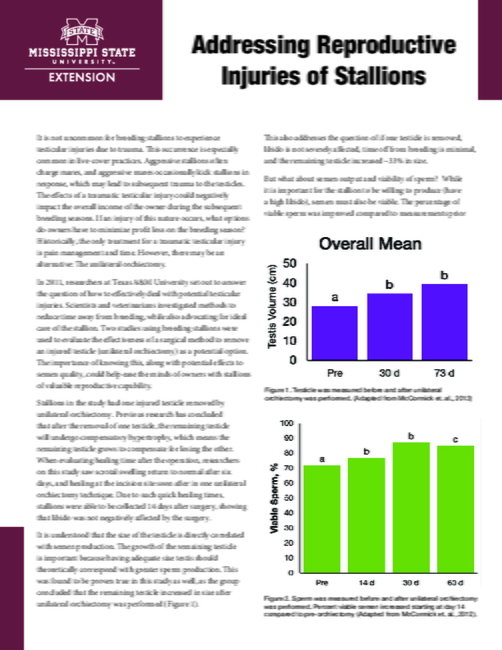Addressing Reproductive Injuries of Stallions
It is not uncommon for breeding stallions to experience testicular injuries due to trauma. This occurrence is especially common in live-cover practices. Aggressive stallions often charge mares, and aggressive mares occasionally kick stallions in response, which may lead to subsequent trauma to the testicles. The effects of a traumatic testicular injury could negatively impact the overall income of the owner during the subsequent breeding seasons. If an injury of this nature occurs, what options do owners have to minimize profit loss on the breeding season? Historically, the only treatment for a traumatic testicular injury is pain management and time. However, there may be an alternative: The unilateral orchiectomy.
In 2011, researchers at Texas A&M University set out to answer the question of how to effectively deal with potential testicular injuries. Scientists and veterinarians investigated methods to reduce time away from breeding, while also advocating for ideal care of the stallion. Two studies using breeding stallions were used to evaluate the effectiveness of a surgical method to remove an injured testicle (unilateral orchiectomy) as a potential option. The importance of knowing this, along with potential effects to semen quality, could help ease the minds of owners with stallions of valuable reproductive capability.
Stallions in the study had one injured testicle removed by unilateral orchiectomy. Previous research has concluded that after the removal of one testicle, the remaining testicle will undergo compensatory hypertrophy, which means the remaining testicle grows to compensate for losing the other. When evaluating healing time after the operation, researchers on this study saw scrotal swelling return to normal after six days, and healing at the incision site soon after in one unilateral orchiectomy technique. Due to such quick healing times, stallions were able to be collected 14 days after surgery, showing that libido was not negatively affected by the surgery.
It is understood that the size of the testicle is directly correlated with semen production. The growth of the remaining testicle is important because having adequate size testis should theoretically correspond with greater sperm production. This was found to be proven true in this study as well, as the group concluded that the remaining testicle increased in size after unilateral orchiectomy was performed (Figure 1).

This also addresses the question of if one testicle is removed, libido is not severely affected, time off from breeding is minimal, and the remaining testicle increased ~33% in size.
But what about semen output and viability of sperm? While it is important for the stallion to be willing to produce (have a high libido), semen must also be viable. The percentage of viable sperm was improved compared to measurements prior to the operation (Figure 2). These findings proved that unilateral orchiectomy was a viable option that does not result in time away from the breeding season nor impacts semen quality. The researchers concluded that the increased semen viability was likely due to the compensatory growth that the remaining testicle experienced. However, this led to more questions in a follow up study which evaluated hormonal effects of unilateral orchiectomy.

In a stallion with a testicular injury and unilateral orchiectomy performed as treatment, adequate semen is produced, libido is not negatively affected by the operation, healing time and time away from breeding is reduced. However, the verdict was still out if hormonal function was compromised by the procedure.
Testosterone production is responsible for producing sperm in the testicles, but luteinizing hormone also plays an important role, as it stimulates Leydig cells in the testes to produce testosterone. Luteinizing hormone and testosterone are equally responsible in sperm production (spermatogenesis).
In the second study, levels of testosterone and luteinizing hormone increased drastically by day 90 post-surgery when compared to the measurements taken before surgery. Again, the group concluded that this was most likely due to the remaining testicle’s compensatory growth causing levels of hormones to increase (Figures 3 and 4).


The results of the two studies concluded that a stallion undergoing unilateral orchiectomy due to trauma of a testicle is a viable option for owners. This procedure will help to minimize profit loss due to less time out of the breeding season with a short time to recovery.
Benefits of Unilateral Orchiectomy
Unilateral Orchiectomy has been evaluated in many species and shown to be a viable option in breeding stock (Wolfe et. al, 1983).
- Compensatory hypertrophy (increase size) of the remaining testicle occurs,
- Semen quality not negatively impacted,
- No extended period of sexual rest necessary post operation, and
- Testosterone and LH not negatively affected
References
Jung, H., Lee, G., Kim, J., Lee, J.-W., & Yoon, M. 2020. “Effects of Hemicastration on Testes and Testosterone Concentration in Stallions.” Journal of Equine Veterinary Science, 92, 103166. Accessed online: https://doi.org/https://doi.org/10.1016/j.jevs.2020.103166
Laron, Z. & Zilka E. 1969. “Compensatory Hypertrophy of Testicle in Unilateral Cryptorchidism.” The Journal of Clinical Endocrinology & Metabolism, Volume 29, Issue 11, 1 November 1969, pp. 1409–1413. Accessed online: https://doi.org/10.1210/jcem-29-11-1409
McCormick J.D., Valdez, R., Rakestraw P.C., Varner D.D., Blanchard T.L., Cavinder C.A., Sudderth, A.K., Kiser A., & Love C.C. 2012. “Effect of surgical technique for unilateral orchiectomy on subsequent testicular function in Miniature Horse stallions.” Equine Vet Journal Supplements. (43):100-4. doi: 10.1111/j.2042-3306.2012.00639.x. PMID: 23447887.
Wolfe D.F., Hudson, R.S., Carson, R.L., & Purohit R.C. 1985. “Effect of unilateral orchiectomy on semen quality in bulls.” Journal of the American Veterinary Medical Association. 1985 Jun 15;186(12):1291-3. PMID: 4019286.
Valdez, R., Cavinder, C. A., PAS, Love, C. C., Vogelsang, M. M., PAS, McCormick, J. D., Rakestraw, P. C., & Dunlap, K. A. 2014. Blood plasma concentrations of testosterone, luteinizing hormone, and estrone sulfate in stallions following hemicastration. Professional Animal Scientist, 30(6), 637-642.
Publication 3739 (POD-02-22)
By Clay Cavinder, PhD, Professor, Department of Animal and Dairy Sciences and Tate Johnson, Master's student, Animal and Dairy Sciences.
